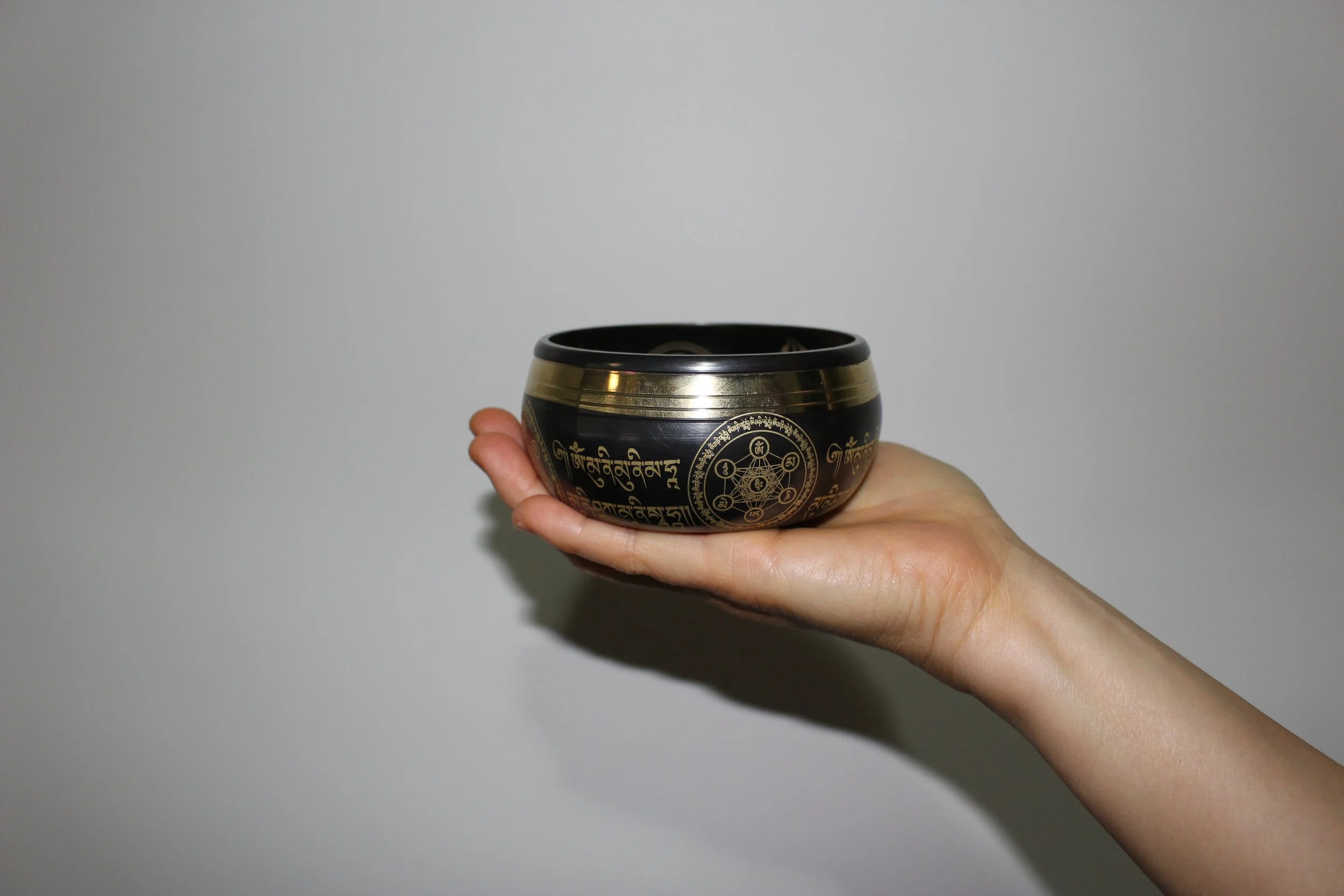
Chakra Guides
All our bowls are labelled with the chakra note. Below is an in depth guide to each chakra’s meaning.
C. Root Chakra (Muladhara)
Location: Base of spine
Color: Red
Focus: Grounding, stability, survival
D. Sacral Chakra (Svadhisthana)
Location: Lower abdomen
Color: Orange
Focus: Creativity, pleasure, relationships
E. Solar Plexus Chakra (Manipura)
Location: Upper abdomen
Color: Yellow
Focus: Personal power, confidence, control
F. Heart Chakra (Anahata)
Location: Center of chest
Color: Green
Focus: Love, compassion, connection
G. Throat Chakra (Vishuddha)
Location: Throat
Color: Blue
Focus: Communication, self-expression, truth
A. Third Eye Chakra (Ajna)
Location: Forehead, between the eyes
Color: Indigo
Focus: Intuition, insight, wisdom
B. Crown Chakra (Sahasrara)
Location: Top of head
Color: Violet
Focus: Spiritual connection, enlightenment, higher consciousness
How to Use Singing Bowls: Extra Large, Large, Medium & Small
Singing bowls are powerful tools for meditation, relaxation, and sound healing. Each size offers its own unique resonance and purpose, from deep grounding vibrations to gentle, personal meditations. Below is a guide to help you connect with your bowl and get the most out of your practice.
Extra Large Bowls
Designed for profound resonance and full-body sound therapy.
Chest Placement: Place the bowl gently on your chest as you lie down before sleep or meditation. The deep tones flow through the entire body, creating balance and harmony.
Floor Resonance: Position the bowl on the floor in front of you or beside your mat during a session. Playing the bowl here fills the space with grounding vibrations.
Immersive Healing: Use in group sound baths or personal deep-healing sessions - the powerful resonance is ideal for shifting energy on a large scale.
Tip: Refer to our How-To Guide for safe practices, as the weight and vibration of extra large bowls require careful handling.
Large Bowls
Created for strong resonance with a slightly more intimate focus than extra large.
Chest Meditation: Rest the bowl on your chest before sleep or meditation to encourage a state of deep calm and open-hearted connection.
Head Meditation: Turn the bowl upside down and place it gently over the crown of the head. Close your eyes and allow the sound vibrations to wash through your mind for clarity and stillness.
Space Clearing: Use the bowl during rituals or meditation to release stagnant energy and uplift the atmosphere of your room.
Medium Bowls
Balanced and versatile, perfect for personal meditation and energy work.
Chest Placement: Place the bowl on your chest to feel its resonant tones flowing through your body.
Palm Holding: Hold the bowl in the palm of your hand and play it with the mallet to create vibrations for self-reflection and grounding.
Body Placement: Position the bowl on areas such as your stomach, back, or thighs to direct healing vibrations where you need them most.
Meditation Support: Ideal to accompany breathing practices, journaling, or intention-setting rituals.
Small Bowls
Delicate and intimate, perfect for everyday mindfulness practices.
Palm Meditation: Rest the bowl in your palm and gently play it during meditation, prayer, or quiet reflection.
Desk or Altar Use: Keep your small bowl nearby during work, study, or spiritual rituals. A short strike can help you reset, focus, or mark the beginning and end of a practice.
Travel-Friendly: Their light size makes them easy to take with you - perfect for meditation on the go.
Finding the Right Bowl for You
Every bowl has its own voice and purpose. Extra large and large bowls are designed to immerse you in powerful, resonant vibrations, while medium and small bowls provide a more personal, gentle experience. Together, they create a complete toolkit for sound healing, meditation, and energy balance.
For best practices and techniques, please refer to our How-To Guide included with your bowl.
How to play your singing bowl
1. Prepare Your Space
Choose a quiet, comfortable area where you won't be disturbed. Sit in a relaxed posture, either cross-legged on the floor or in a chair with your feet flat. Ensure your spine is straight to allow for deep, even breathing.
2. Position the Bowl
If using a smaller bowl, place it in the palm of your non-dominant hand, keeping your fingers extended and relaxed. For larger bowls, set them on a cushion or soft surface to allow free vibration and prevent dampening the sound.
3. Select the Right Mallet
Singing bowls can be played with various mallets:
Suede Leather Wrapped Mallet: Offers a softer, warmer sound.
Merino Wool Felt Mallet: Ideal for gentle, mellow tones.
Experiment with different mallets to discover the sound quality you prefer.
4. Striking Technique
Gently strike the bowl's rim or upper outer wall with the mallet to produce an initial tone. Allow the sound to resonate fully before striking again. This method is excellent for beginning a meditation session or signaling transitions.
5. Rimming Technique
To create a continuous, harmonious sound:
Hold the mallet firmly but gently, as you would a pen.
Place the mallet against the bowl's rim at a slight angle.
Apply consistent pressure and move the mallet around the rim in a clockwise direction.
The bowl will begin to "sing" as the friction induces vibrations. Maintain a steady speed to keep the tone smooth and avoid choppiness.
6. Practice Mindful Listening
As the bowl emits sound, focus your attention on the tone and vibrations. Allow the sound to guide your meditation, bringing awareness to the present moment and helping to quiet the mind.
Tips for Effective Practice
Start Slowly: Begin with short sessions, gradually increasing duration as you become more comfortable.
Experiment: Try different mallets and striking points to explore various tones and vibrations.
Consistency: Regular practice enhances your connection with the bowl and deepens the meditative experience.
Inside Nepal Guide to Beginning Your Sound Journey
It all begins with an idea.
Inside Nepal Guide to Beginning Your Sound Journey
At Inside Nepal, we believe a singing bowl is more than just a tool—it is a companion on your journey into stillness, healing, and clarity. If you're here, you’re likely searching for your first bowl. Whether for meditation, space cleansing, or sound healing, this guide can help you find the bowl that truly resonates with you.
Start With Intention
Before choosing, ask yourself what you’re hoping to invite in. A sense of calm? Focus? A deeper meditation practice? Each bowl carries a vibration that interacts with your energy field. The most important part is how it makes you feel. Trust that instinct.
Listen With Your Body, Not Just Your Ears
Each singing bowl has a base note and a series of overtones. These sounds align with different chakras or energy centers in the body. You might find a bowl labeled for the Heart Chakra (F note) resonates more in your Solar Plexus or vice versa. There is no wrong answer, only the right sound and vibration for you.
Size and Sound
Larger bowls around 17cm and up produce deeper, more grounding tones and strong vibrations. These are wonderful for whole-body relaxation and easier to play for beginners.
Smaller bowls sing at a higher pitch and can feel more energizing. They're lovely for meditation but can be slightly more difficult to play consistently.
Many of our customers begin with a medium-to-large bowl and later complement it with a smaller one.
New or Antique
Antique bowls tend to have warmer, more complex tones and lighter weight due to their age and craftsmanship. They’re often more expensive but prized for their character and energetic presence.
New handmade bowls, like those we source from Nepal, can offer equally rich sound, especially when hand-hammered using traditional 7-metal blends.
Handmade vs Machine-Made
We believe in craftsmanship. Our bowls are entirely handmade in Nepal by artisans who have inherited this knowledge through generations. While machine-made bowls can look polished, they often lack the warmth, depth, and nuance of a true handmade singing bowl.
Pricing and Budget
There’s a wide range when it comes to price. If you’re just starting, it’s not about how expensive your bowl is but how connected you feel to it. Let your intuition guide you more than your wallet.
Our Suggestion
Start with a handmade bowl around 17 to 24cm, ideally with a suede and wool mallet, and listen to the sound samples we provide. Let the tone settle in your body. If it feels grounding, peaceful, or expansive—you’ve found your bowl.
“My first bowl was a full Moon bowl for the Heart Chakra. When I struck it the first time, I had tears streaming down my face that I couldn’t control. That’s when I knew it was mine.” – Eileen, Sound Practitioner at Inside Nepal
Still Unsure
We’re here to help. Give us a call at +61 0429 905 766. We test each bowl by hand and would love to help you find one that supports your healing journey.
Ready to begin
Explore our handmade singing bowls →
